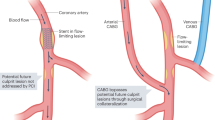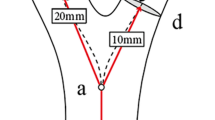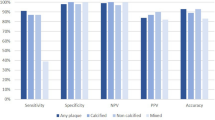Abstract
Background The reliability of imaging techniques to assess early atherosclerosis remains unclear. We did a cross-sectional, prospective study to test reproducibility of MRI when imaging arteries, to assess risk of cardiovascular disease and correlations with age and sex.
Methods Between January 2003 and December 2006 we performed black-blood MRI of both common carotid arteries and the thoracic descending aorta in patients with cardiovascular risk factors who were referred from clinics in New York, NY, USA. Mean wall area, wall thickness, lumen area, total vessel area, and ratio of the mean wall area to the mean total vessel area (WA/TVA) were manually measured. Reproducibility within and between readers was tested on subsets of images from randomly chosen patients.
Results MRI was performed on 300 patients. Intrareader reproducibility, assessed in images from 20 patients, was high for all parameters (intraclass correlation coefficients >0.8), except WA/TVA ratio in the descending aorta. The inter-reader reproducibility, assessed in images from 187 patients, was acceptable (intraclass correlation coefficients >0.7) for the mean wall, lumen, and total vessel areas. Values for all MRI parameters in all vessels increased with increasing age for both sexes (all P <0.0005) but were always significantly higher in men than in women, except for aortic mean wall thickness and WA/TVA ratio in the carotid arteries. Mean wall area values correlated well between the carotid arteries and aorta, reflecting the systemic nature of atherosclerosis.
Conclusions Our findings support MRI as a reproducible measurement of plaque burden and demonstrate the systemic distribution of atherosclerosis.
Key Points
-
MRI is quickly becoming the preferred method for the noninvasive evaluation of the vessel wall in advanced atherosclerotic cardiovascular disease
-
MRI measurements of atherosclerotic plaque burden are reproducible
-
The MRI values for the mean wall areas correlated strongly between carotid arteries and aorta, suggesting a systemic distribution of disease
-
Similar to other clinical variables for cardiovascular diseases, values for MRI parameters were higher in men than in women
-
MRI measures of plaque burden increased with increasing age
This is a preview of subscription content, access via your institution
Access options
Subscribe to this journal
Receive 12 print issues and online access
$209.00 per year
only $17.42 per issue
Buy this article
- Purchase on Springer Link
- Instant access to full article PDF
Prices may be subject to local taxes which are calculated during checkout






Similar content being viewed by others
References
Sanz J and Fayad ZA (2008) Imaging of atherosclerotic cardiovascular disease. Nature 451: 953–957
Fayad ZA et al. (2000) Noninvasive in vivo human coronary artery lumen and wall imaging using black-blood magnetic resonance imaging. Circulation 102: 506–510
Corti R et al. (2001) Effects of lipid-lowering by simvastatin on human atherosclerotic lesions: a longitudinal study by high-resolution, noninvasive magnetic resonance imaging. Circulation 104: 249–252
Corti R et al. (2002) Lipid lowering by simvastatin induces regression of human atherosclerotic lesions: two years' follow-up by high-resolution noninvasive magnetic resonance imaging. Circulation 106: 2884–2887
Wyttenbach R et al. (2004) Effects of percutaneous transluminal angioplasty and endovascular brachytherapy on vascular remodeling of human femoropopliteal artery by noninvasive magnetic resonance imaging. Circulation 110: 1156–1161
Coulden RA et al. (2000) High resolution magnetic resonance imaging of atherosclerosis and the response to balloon angioplasty. Heart 83: 188–191
Fayad ZA et al. (2000) In vivo magnetic resonance evaluation of atherosclerotic plaques in the human thoracic aorta: a comparison with transesophageal echocardiography. Circulation 101: 2503–2509
Kang X et al. (2000) Analysis of the measurement precision of arterial lumen and wall areas using high-resolution MRI. J Magn Reson Med 44: 968–972
Desai MY et al. (2005) Reproducibility of 3D free-breathing magnetic resonance coronary vessel wall imaging. Eur Heart J 26: 2320–2324
Yuan C et al. (1998) Measurement of atherosclerotic carotid plaque size in vivo using high resolution magnetic resonance imaging. Circulation 98: 2666–2667
Saam T et al. (2006) Predictors of carotid atherosclerotic plaque progression as measured by noninvasive magnetic resonance imaging. Atherosclerosis 194: e34–e42
Itskovich VV et al. (2004) Parallel and nonparallel simultaneous multislice black-blood double inversion recovery techniques for vessel wall imaging. J Magn Reson Imaging 19: 459–467
Mani V et al. (2004) Rapid extended coverage simultaneous multisection black-blood vessel wall MR imaging. Radiology 232: 281–288
Hatsukami TS et al. (2000) Visualization of fibrous cap thickness and rupture in human atherosclerotic carotid plaque in vivo with high-resolution magnetic resonance imaging. Circulation 102: 959–964
VesselMass software (Leiden University Medical Center, The Netherlands)
van der Geest RJ et al. (1999) Quantification in cardiac MRI. J Magn Reson Imaging 10: 602–608
Woodward M (2004) Epidemiology: Study Design and Data Analysis, edn 2. Boca Raton, FL: Chapman and Hall/CRC Press
McGraw KO and Wong S P (1996) Forming inferences about some intraclass correlation coefficients. Psychol Methods 1: 30–46
Bland JM and Altman DG (1986) Statistical methods for assessing agreement between two methods of clinical measurements. Lancet 1: 307–310
Satterthwaite FE (1946) An approximate distribution of estimates of variance components. Biometrics Bull 2: 110–114
SPSS® version 14.0 (SPSS Inc., Chicago, IL)
SAS® version 9 (SAS Institute Inc., Cary, NC)
Mani V et al. (2005) Comparison of gated and nongated fast multislice black-blood carotid imaging using rapid extended coverage and inflow/outflow saturation techniques. J Magn Reson Imaging 22: 628–633
Touzé E et al. (2007) Reproducibility of high-resolution MRI for the identification and the quantification of carotid atherosclerotic plaque components: consequences for prognosis studies and therapeutic trials. Stroke 38: 1812–219
Li AE et al. (2004) Using MRI to assess aortic wall thickness in the multiethnic study of atherosclerosis: distribution by race, sex, and age. AJR Am J Roentgenol 182: 593–597
Nissen SE (2002) Application of intravascular ultrasound to characterize coronary artery disease and assess the progression or regression of atherosclerosis. Am J Cardiol 89: 24B–31B
Bots ML et al. (1994) Reproducibility of carotid vessel wall thickness measurements. The Rotterdam Study. J Clin Epidemiol 47: 921–930
Tang R et al. (2000) Baseline reproducibility of B-mode ultrasonic measurement of carotid artery intima-media thickness: the European Lacidipine Study on Atherosclerosis (ELSA). J Hypertens 18: 197–201
Hagenaars T et al. (2000) Reproducibility of volumetric quantification in intravascular ultrasound images. Ultrasound Med Biol 26: 367–374
Touboul PJ et al. (2005) Design, baseline characteristics and carotid intima-media thickness reproducibility in the PARC study. Cerebrovasc Dis 19: 57–63
Lorenz MW et al. (2007) Prediction of clinical cardiovascular events with carotid intima-media thickness: a systematic review and meta-analysis. Circulation 115: 459–467
Howard G et al. (1994) Relations of intimal-medial thickness among sites within the carotid artery as evaluated by B-mode ultrasound. ARIC Investigators. Atherosclerosis Risk in Communities. Stroke 25: 1581–1587
Adams GJ et al. (2002) Bilateral symmetry of human carotid artery atherosclerosis. Stroke 33: 2575–2580
Chambless LE et al. (1997) Association of coronary heart disease incidence with carotid arterial wall thickness and major risk factors: the Atherosclerosis Risk in Communities (ARIC) Study, 1987–1993. Am J Epidemiol 146: 483–494
O'Leary DH et al. (1999) Carotid-artery intima and media thickness as a risk factor for myocardial infarction and stroke in older adults. Cardiovascular Health Study Collaborative Research Group. N Engl J Med 340: 14–22
Haberl R et al. (2001) Correlation of coronary calcification and angiographically documented stenoses in patients with suspected coronary artery disease: results of 1,764 patients. J Am Coll Cardiol 37: 451–457
Joakimsen O et al. (1999) Age and sex differences in the distribution and ultrasound morphology of carotid atherosclerosis: the Tromso Study. Arterioscler Thromb Vasc Biol 19: 3007–3013
Jaffer FA et al. (2002) Age and sex distribution of subclinical aortic atherosclerosis: a magnetic resonance imaging examination of the Framingham Heart Study. Arterioscler Thromb Vasc Biol 22: 849–854
Acknowledgements
This investigation was partially supported by NIH/NHLBI grant R01 HL071021 (ZA Fayad). H El Aidi was supported by the Huygens Scholarship Programme of the Dutch Ministry of Education, Culture and Science. V Mani is supported by a postdoctoral fellowship from the Founders Affiliate of the American Heart Association. We thank the study participants and Hannah Oltarzewska and Frank Macaluso for technical assistance. We further acknowledge Verheugt Freek for his assistance.
Author information
Authors and Affiliations
Corresponding author
Supplementary information
Supplementary Figure 1
Non-overlapping cross-sectional MRI slices of the carotid arteries were obtained using the rapid extended coverage double inversion recovery turbo spin echo black blood (REX) pulse sequence (DOC 584 kb)
Supplementary Figure 2
Non-overlapping cross-sectional MRI slices of the aorta were obtained using the rapid extended coverage double inversion recovery turbo spin echo black blood (REX) pulse sequence. (DOC 709 kb)
Rights and permissions
About this article
Cite this article
Aidi, H., Mani, V., Weinshelbaum, K. et al. Cross-sectional, prospective study of MRI reproducibility in the assessment of plaque burden of the carotid arteries and aorta. Nat Rev Cardiol 6, 219–228 (2009). https://doi.org/10.1038/ncpcardio1444
Received:
Accepted:
Published:
Issue Date:
DOI: https://doi.org/10.1038/ncpcardio1444
This article is cited by
-
3D black blood VISTA vessel wall cardiovascular magnetic resonance of the thoracic aorta wall in young, healthy adults: reproducibility and implications for efficacy trial sample sizes: a cross-sectional study
Journal of Cardiovascular Magnetic Resonance (2016)
-
Predictors of change in carotid atherosclerotic plaque inflammation and burden as measured by 18-FDG-PET and MRI, respectively, in the dal-PLAQUE study
The International Journal of Cardiovascular Imaging (2014)
-
Relationship between particulate matter exposure and atherogenic profile in “Ground Zero” workers as shown by dynamic contrast enhanced MR imaging
The International Journal of Cardiovascular Imaging (2013)
-
Carotid plaque regression following 6-month statin therapy assessed by 3T cardiovascular magnetic resonance: comparison with ultrasound intima media thickness
Journal of Cardiovascular Magnetic Resonance (2011)
-
Variations in atherosclerosis and remodeling patterns in aorta and carotids
Journal of Cardiovascular Magnetic Resonance (2010)



